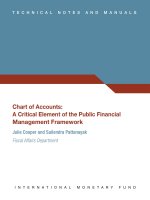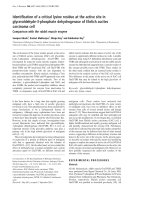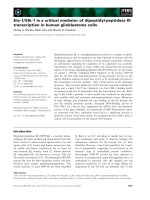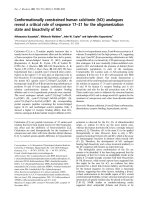A critical comprehension of carbon neutral management practices in agriculture by tribal farmers of Betul district of M.P, India
Bạn đang xem bản rút gọn của tài liệu. Xem và tải ngay bản đầy đủ của tài liệu tại đây (190.41 KB, 6 trang )
Int.J.Curr.Microbiol.App.Sci (2020) 9(5): 2032-2037
International Journal of Current Microbiology and Applied Sciences
ISSN: 2319-7706 Volume 9 Number 5 (2020)
Journal homepage:
Original Research Article
/>
A Critical Comprehension of Carbon Neutral Management Practices in
Agriculture by Tribal Farmers of Betul District of M.P, India
G. Bihare1*, P. Kumar2, Singhshivpal3, G. Uikey1 and S. K. Badodiya1
1
Department of Agriculture Extension Education, College of Agriculture,
Gwalior-474002, India
2
Department of Agriculture Extension Education, College of Agriculture,
Indore-452001, India
3
Department of Agriculture Extension Education, Jawaharlal Nehru Krishi Krishi Vishwa
Vidyalaya Jabalpur M.P, 482007, India
*Corresponding author
ABSTRACT
Keywords
Eco-Friendly
Practices, Tribal
Farmers, ill effect,
Agrochemical
Article Info
Accepted:
15 April 2020
Available Online:
10 May 2020
The present study was conducted in Sahapur and Bhimpur block were purposively
selected based on tribal area of Betul district of M.P. The total sample was
consisted 120 respondents for the study. Objective of study is to study the profile
of tribal farmers, and to seek suggestive measure to minimize the ill effect of
agrochemical as perceived by tribal farmers. maximum respondents were from
middle age group having maximum respondents educated up to primary level,
having medium size of family, most of the respondents had medium social
participation, having marginal size of land holding, having medium annual
income, maximum respondent were in medium category regarding credit
availability, having medium source of information category, approximately half of
the respondents were in medium category regarding material possession, having
medium category of extension contact also extension participation, as well as
medium category regarding innovativeness.
Introduction
In today’s word, Agriculture and technology
are the backbone of an economy. While
agriculture makes significant contribution to
the economic development of less developed
countries.
Environmentally
friendly
agriculture production is the process in which
crops are grown naturally without the use of
chemicals. The main purpose of this activity
is to produce agriculture without harming the
environment. This kind of farming is a
production process which avoids or largely
excludes using synthetically compounded
2032
Int.J.Curr.Microbiol.App.Sci (2020) 9(5): 2032-2037
fertilizers, plant hormones and dairy cattle
feed additives. a feed additive is an additive
of extra nutrient or drug for livestock which
are harming dairy animals. with the increase
in population, the demand for food material
increased and the use of chemicals, fertilizers
were continually used for more crop
production.
Therefore, a study was conducted with the
following objectives for the study includes to
study the profile of tribal farmers. And also to
seek suggestive measure to minimize the ill
effect of agrochemical as perceived by tribal
farmers.
Fertilizer application in India is large and the
use of agrochemicals for greater crop
production had ill effect on human health,
environment and groundwater. The significant
eco-accommodating advances deserving of
referencing are organic farming, natural
farming, traditional farming, sustainable
farming, and permaculture, which may be all
together considered as eco-friendly farming.
The present study was conducted in Sahapur
and Bhimpur block of Betul district of M.P.
From Betul district, Sahapur and Bhimpur
Blocks were purposively selected based on
tribal area of the district. The selected blocks
comprise of 295 villages. A combined list of
villages of both selected blocks where tribal
farmers were engaged in agriculture was
prepared with help of extension officials.
Ecological pesticides and green pesticides are
those that are environmentally friendly, these
pesticides do not harm environment, soil,
water, animals and microorganism. In
agriculture science, pesticides are evaluated
for minimum environmental impact. An
environmentally
friendly
agricultural
technique, which does not harm nature,
ensure food security, improve human health
and plays an important role in conserving the
environment.
Out of these, 10 villages were selected
randomly for the study. After the selection of
the villages, a village wise list of tribal
farmers was prepared and twelve tribal
farmers were selected in each village by using
simple random sampling method.
Sustainable agricultural systems should be
equitable in providing long-term food
sufficiency, and social justice, and ecological
sound for future generations and other
species. The success of eco-friendly farm
approach totally depends on awareness
approach supported by the authentic source of
input and knowledge from technical person.
Therefore, it is essential to judge the depth of
perception and adopt among the concerned
farmers in relation to eco-friendly farming
which is a prerequisite to developed a strategy
for successful implementation of eco-friendly
farming programme for a governmental
organization particular farming community.
Materials and Methods
Thus, the total sample was consisted 120
respondents for the study. The data were
collected personally with the help of a pretested interview schedule. The interview
schedule was designed for collecting the
relevant information of selected variables. All
the respondents had answered the questions
fully, which was indicative of the fact that
good rapport could be established between the
investigator and respondents.
After establishing rapport with the
respondents, they were interviewed and their
responses recorded in interview schedule, for
analysis of data. Secondary data were
collected from records & statistical office.
Statistical tools like- mean, SD, percentage
and Karl Pearson’s coefficient of correlation
and multiple regression analysis [1-9].
2033
Int.J.Curr.Microbiol.App.Sci (2020) 9(5): 2032-2037
Results and Discussion
The data in Table 1 shows that maximum
number of the respondents (48.33%) belonged
to middle age group, followed by old age
(20%). Higher percentage of the respondents
(31.67%) were educated up to primary level
followed by (24.17%) middle school level,
whereas, 12.50 per cent Illiterate, 20.83 per
cent high school and 10.83 per cent of the
respondents were above high school.
Majority of the respondents (44.16%)
belonged to medium size of family (5 to 8
members), followed by 34.16 per cent
respondents had large size of family (>8
members). Out of the total 120 tribal farmers,
25.83 percent respondents had low social
participation; followed by 40.84 per cent
respondents had medium social participation.
41.67 per cent respondents were marginal
farmers, followed by 27.5 per cent had small
size of land holding, 15.83 per cent
respondents were from medium category, and
15.00 per cent were in large category.
Majority 56.67 per cent respondents were
having medium annual income while 25 per
cent of the respondents had low level annual
income and 18.33 per cent had high annual
income
46.66 per cent respondents were in medium
credit availability category, while 17.5 per
cent of the respondents were high level credit
availability. The data showed that 57.50 per
cent of the respondents engaged in agriculture
followed by 25.84 percent of the respondents
engaged in agriculture and only 16.66 percent
respondents engaged in agriculture+ business
+service/other.
Higher percentage of respondents (56.67%)
was found in the medium Source of
information category followed by 19.17 per
cent in the low category. It is apparent from
the Table 1 that majority (49.17%) of the
tribal farmers possessed medium level of
material possession, while 26.67 per cent
possessed low medium level of material
possession.
It is evident from the Table 1 that the majority
55.00 percent of respondents were from
medium category of extension contact, while
18.34 percent of respondents were in low
category of extension contact. It shows that
out of total 120 respondent maximum 47.5 %
respondent were found to be in the medium
extension participation category, while 23.33
% respondent were in the high extension
participation category.
Majority of the respondents 40.83 per cent
were in medium innovativeness category
followed by 26.67 per cent in low category
and only 32.5 per cent in high category of
Innovativeness. As regard to the knowledge
of eco-friendly practices, majority (66.67%)
of the respondents had medium, 21.66 per
cent high and 11.67 per cent low level of
knowledge about eco-friendly practices.
Adequate knowledge of any improved
practice is a pre-requisite for its adoption.
Research studies established that knowledge
of an innovation would lead to its eventual
adoption. The result expressed by the
respondents regarding knowledge about ecofriendly practices was medium.
Information regarding the different aspects of
environmental
hazards
(ill-effects
of
chemicals like their effect on human health,
toxicity to animals, hazards to environment,
non-target organisms, resistance developed by
pests etc.) and eco-friendly practices
(Integrated Pest Management and Integrated
Nutrient Management) were collected from
good number of relevant literature, books and
consulting experts.
2034
Int.J.Curr.Microbiol.App.Sci (2020) 9(5): 2032-2037
Table.1 Socio-economic profile of respondents
SN
1
Traits
Age
2
Education
3
Family Size
4
Social
Participation
5
Annual
Income
6
Land Holding
7
Credit
Availability
8
Occupation
9
Source of
Information
10
Material
Possession
11
Extension
Contact
Category
Frequency Percentage Mean SD
Young age (Below 35 years)
38
31.67
Middle age (35 to 50 years)
58
48.33
Old age (Above 50 years)
24
20
Illiterate
Primary school
Middle school
High School
Above high school
Small (<5 members)
Medium (5 to 8 members)
Large (>8 members)
Low (up to 4 score)
Medium (5 to 9 score)
High (Above 9 score)
Low (Up to Rs 50,000/-)
Medium (Rs. 50,001 to 1,00,000/-)
High (Above Rs. 1,00,000)
Marginal farmers (< 1ha.)
Small farmers (1-2ha.)
Medium farmers (2.1- 5 ha.)
Large farmers (> 5 ha.)
Poor credit availability
Moderate credit availability
Good credit availability
Agriculture (1score)
Agriculture+ business (2 score)
Agriculture+ business
+service/other (3 score)
Low (< 1.4 score)
Medium (between 1.4 to 2.8)
High (> 2.8)
Low (< 1.26 score)
Medium (between 1.26 to 2.70)
High (> 2.70)
Low (below 3 times in a season)
Medium (3 to 6 times in a season)
High (above 6 times in a season)
15
38
29
25
13
26
53
41
31
49
40
30
68
22
50
33
19
18
43
56
21
31
69
20
12.5
31.67
24.17
20.83
10.83
21.67
44.16
34.17
25.83
40.84
33.33
25
56.67
18.33
41.67
27.5
15.83
15
35.84
46.66
17.5
25.84
57.5
16.66
23
68
29
32
59
29
22
66
32
19.17
56.67
24.16
26.67
49.17
24.16
18.34
55
26.66
2035
2.10
0.7
1.98
0.72
Int.J.Curr.Microbiol.App.Sci (2020) 9(5): 2032-2037
12
Extension
Participation
13
Innovativeness
14
Distribution of
respondents
according to
their
knowledge
Low Extension participation
Medium Extension participation
High Extension participation
Low (< 1.288 score)
Medium (between 1.288 to2.828)
High (> 2.828)
Low (< 23.064)
Medium (23.064–28.936)
High (> 28.936)
35
57
28
32
49
39
14
80
26
29.17
47.5
23.33
26.67
40.83
32.5
11.67
66.67
21.66
2.06
0.77
26.00
2.936
Table.2 Suggestive measure to minimise the ill effect of agrochemicals as perceived by farmers
S. N.
1
2
3
4
5
6
7
8
9
10
Suggestions made
Making available pest resistant varieties
Organizing training on eco-friendly practices
Encouraging farmers to grow organic Agriculture crops
through subsidies, technical guidance etc.
Ensure strict quality control measures for pesticides
Use of bio-pesticides and bio-fertilizers must be increases
Use of bio-control agents in control of pests must be
increased
Give premium price for organically growing Agriculture
Educate public and farmers about the environmental issues
Establishing a network of farmers adopting organic farming
Introducing environmental education at the secondary level
Measures to minimize the ill effects of
agrochemicals
The results in Table 2 indicated that the
majority of the respondents suggested making
availability of pest resistant varieties
(87.50%), followed by three-fourth of
respondents said organizing training on ecofriendly practices (75.00%).
The results in Table 2 indicated that the
majority of the respondents suggested making
availability of pest resistant varieties
(87.50%), followed by three-fourth of
respondents said organizing training on ecofriendly practices (75.00%). Nearly two-third
of respondents suggested encouraging farmers
to grow organic Agriculture through subsides,
Frequency
105
90
83
Percent
87.50
75.00
69.17
79
65
59
65.83
54.17
49.17
42
56
35
38
35.00
46.67
29.17
31.67
technical support etc. (69.17%) and ensure
quality control measures for pesticides
(65.83%). Use of bio-pesticides and biofertilizers must be increased was suggested by
54.17 per cent of the respondents.
Nearly fifty per cent of the respondents
suggested about use of bio-control agents in
control of pest must be increased (49.17%)
and educating public and farmers about
environmental issues (46.67%). Thirty-five
per cent farmers suggested about giving
premium price for organically grown
agriculture. Introduction of environmental
education at secondary level and establishing
a network of farmers adopting organic
farming was suggested by 31.67 per cent and
29.17 per cent, respectively.
2036
Int.J.Curr.Microbiol.App.Sci (2020) 9(5): 2032-2037
The study revealed that variables like
education, social participation, size of land
holding, annual income, credit availability,
occupation, source of information, material
possession, extension contact, extension
participation and innovativeness were
positively and significantly correlated with
knowledge about eco-friendly practices at 1
percent level of significance and education,
social participation, credit availability,
extension participation, extension contact and
innovativeness
were
positively
and
significantly correlated with adoption of ecofriendly practices at 1 percent level of
significance.
References
Agriculture-Man-Ecology (1991). Sustainable
agriculture-intensive research will
play off. The Hindu, Survey of Indian
Agriculture, pp. 17-20.
Agriculture-Man-Ecology (1992). Ecological
Agriculture
in
South
India,
Agricultural Economics Research
Institute. The Hauge, Netherlands, pp.
70.
Badodiya S.K.; Daipuria O. P.; Jaulkar A. M.
and U. Dhakad (2010) Management of
eco-friendly practices by winter
vegetable growers. Paper presented in
National Seminar on Organic Farming
& Published
Gour et al., (2014) Knowledge of winter
vegetable growers about eco-friendly
practices, SKUAST Journal of
Agriculture Research, 16: 105-112.
Mandavi Mishra, Role of Eco-Friendly
Agricultural Practices in Indian
Agriculture
Development,
International Journal of Agriculture
and Food Science Technology
(IJAFST) ISSN No. 2249-3050,
Volume 4 No. 2 (2013)
Neerja Patel, Sandhya Choudhary, &Dr. V. K.
Swarnakar Study on Adoption of EcoFriendly Management Practices by
Vegetable Growers in Indore Block of
Indore District (M.P.) IOSR Journal of
Agriculture and Veterinary Science
Rane Satish, (2016) “A Study on Adoption of
Eco-friendly
Farming
Practices
Among Rice Grower of Hanumana
Block of Reva District (M.P),
Unpublished M.Sc. (Ag) Thesis,
collage
of
Agriculture
JNKVVJabalpur (M.P)
S. Srisruthi, N. Swarna, G. M. S. Ros and E.
Elizabeth, "Sustainable agriculture
using eco-friendly and energy efficient
sensor technology," 2016 IEEE
International Conference on Recent
Trends in Electronics, Information &
Communication
Technology
(RTEICT), Bangalore, 2016, pp. 14421446.
How to cite this article:
Bihare, G., P. Kumar, Singhshivpal, G. Uikey and Badodiya, S. K. 2020. A Critical
Comprehension of Carbon Neutral Management Practices in Agriculture by Tribal Farmers of
Betul District of M.P, India. Int.J.Curr.Microbiol.App.Sci. 9(05): 2032-2037.
doi: />
2037









